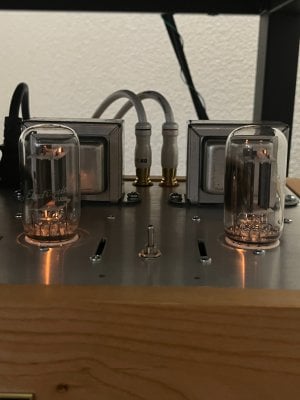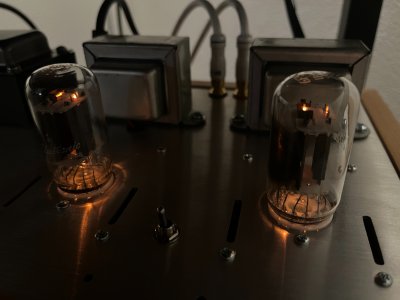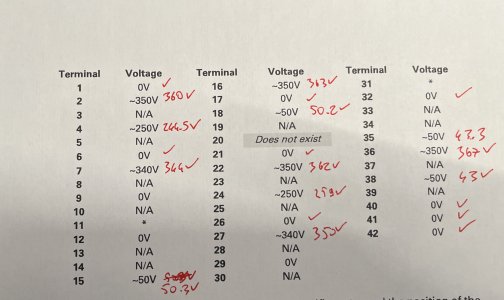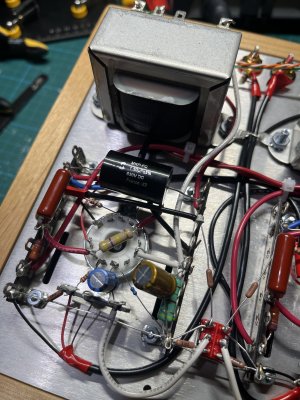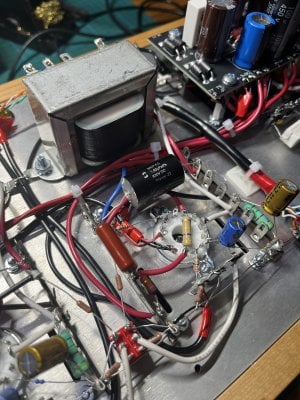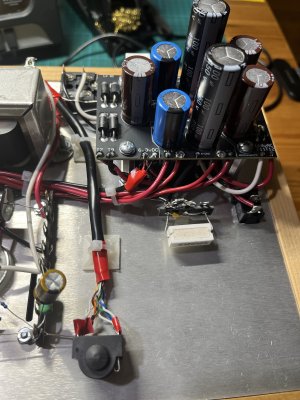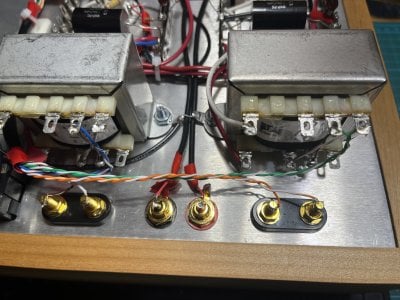You are using an out of date browser. It may not display this or other websites correctly.
You should upgrade or use an alternative browser.
You should upgrade or use an alternative browser.
less volume on the right channel [resolved]
- Thread starter mete
- Start date
Are there any voltage discrepancies?
You can set your meter to DC voltage and measure the voltage between pins 1 and 12 on the offending side to check the heater voltage. It should be about 6.3V, but it would have to be a lot lower than that to see reduced emission (I'd expect ~5.7V or so and you might encounter a problem).
If you swapped tubes and the issue stayed on one side, then you'll want to reflow your solder joints and poke around to look for loose connections.
If you swapped tubes and the issue stayed on one side, then you'll want to reflow your solder joints and poke around to look for loose connections.
You can set your meter to DC voltage and measure the voltage between pins 1 and 12 on the offending side to check the heater voltage. It should be about 6.3V, but it would have to be a lot lower than that to see reduced emission (I'd expect ~5.7V or so and you might encounter a problem).
Without any tube, I read a little over 8V, I measured pads 4V so I guess it is normal. With one tube attached, other is ~6.7V. I checked in both sockets, they are more or less the same.
Edit: When both tubes are connected, DC pads show 2.9V.
Last edited:
If you swapped tubes and the issue stayed on one side, then you'll want to reflow your solder joints and poke around to look for loose connections.
I have actually poked around after voltage check before plugging it in but I do that again. Is there any component or connection I need to pay particular attention ? Is this related to the difference in voltages between T15 and T35 ?
Edit: I might have mistaken before. I measured T15, T35 again now, and I see them reverse. I might have swapped the tubes compared to when I did voltage check. Can this be caused by the difference in the tube ?
Last edited:
I am quite confused. I believe the voltage difference in T15 vs. T35 is due to the tube. But the volume difference is not because of that, I again tested swapping the tube and it is always the right channel. I checked the connections etc. and reflowed a few but nothing changed.
Regarding the tubes, the heater glowing like a line is similar in both, but the other one, glowing more like a point or a drop is slightly different looking.
Regarding the tubes, the heater glowing like a line is similar in both, but the other one, glowing more like a point or a drop is slightly different looking.
You need to measure the DC voltage between pins 1 and 12 on the offending tube socket and report that DC voltage, not the voltage on "pads".Edit: When both tubes are connected, DC pads show 2.9V.
With one tube attached, other is ~6.7V. I checked in both sockets, they are more or less the same.You need to measure the DC voltage between pins 1 and 12 on the offending tube socket and report that DC voltage, not the voltage on "pads".
To summarize:
- I have less volume on the right channel. It doesnt change if I swap the tubes.
- I have less voltage on T15/T18 when one tube is on that side, this changes to T35/38 if tube is swapped. You can see all other voltages in the voltage check table above.
- I checked the connections and reflowed a few, nothing changed.
- When one tube is plugged, I measure 6.7V on the other sockets heater pins (1-12).
- I see a visual difference in the glow on one of the heaters if it matters.
- I have less volume on the right channel. It doesnt change if I swap the tubes.
- I have less voltage on T15/T18 when one tube is on that side, this changes to T35/38 if tube is swapped. You can see all other voltages in the voltage check table above.
- I checked the connections and reflowed a few, nothing changed.
- When one tube is plugged, I measure 6.7V on the other sockets heater pins (1-12).
- I see a visual difference in the glow on one of the heaters if it matters.
Both sockets are 6.7V with both tubes in both sockets?
You need to check the DC voltage between pins 1 and 12 on both sockets with both tubes installed to be sure both of those DC voltages are the same (these are the voltages that make the tubes glow, and this will either confirm that your observed difference in brightness matters, or it will tell us that there's nothing significant to that observation).
You need to check the DC voltage between pins 1 and 12 on both sockets with both tubes installed to be sure both of those DC voltages are the same (these are the voltages that make the tubes glow, and this will either confirm that your observed difference in brightness matters, or it will tell us that there's nothing significant to that observation).
Both are 5.8V with both tubes installed.Both sockets are 6.7V with both tubes in both sockets?
You need to check the DC voltage between pins 1 and 12 on both sockets with both tubes installed to be sure both of those DC voltages are the same (these are the voltages that make the tubes glow, and this will either confirm that your observed difference in brightness matters, or it will tell us that there's nothing significant to that observation).
I fixed at least the majority of the issue, if there is any difference in volume now, it is very minor. I believe it was due to a cold joint, maybe at headphone jack wiring, OT-2 wiring or output coupling cap wiring. I did quite a massive reflow, also with higher temperature.
Edit: It was ~17dB difference before, now it is ~1.5dB.
Edit: It was ~17dB difference before, now it is ~1.5dB.
Last edited:
Similar threads
- Replies
- 19
- Views
- 561

